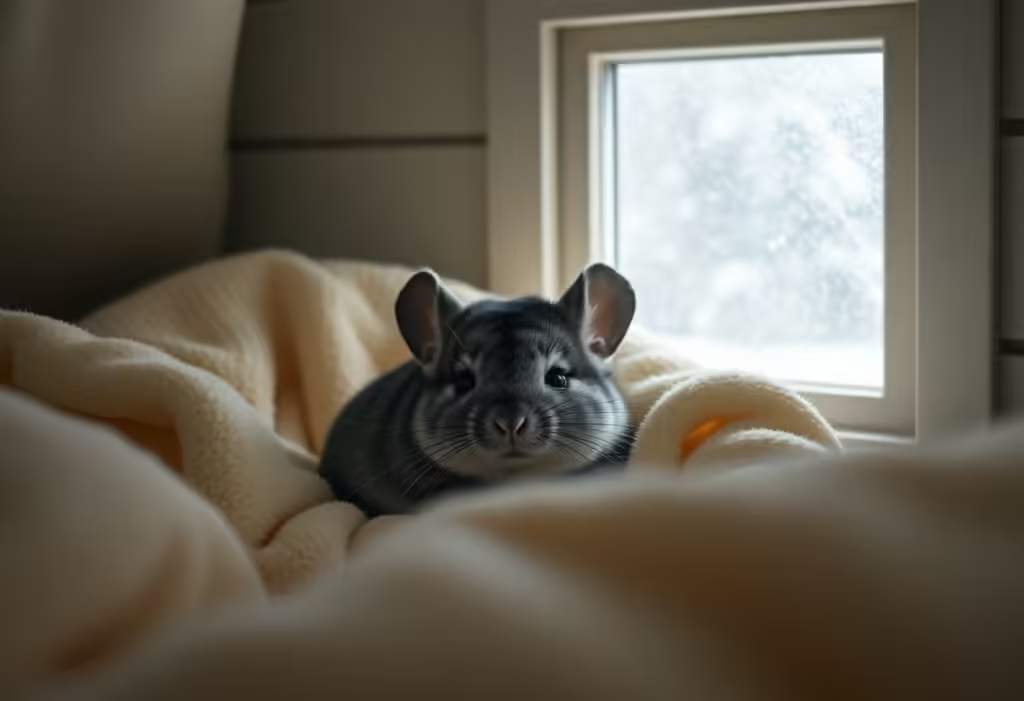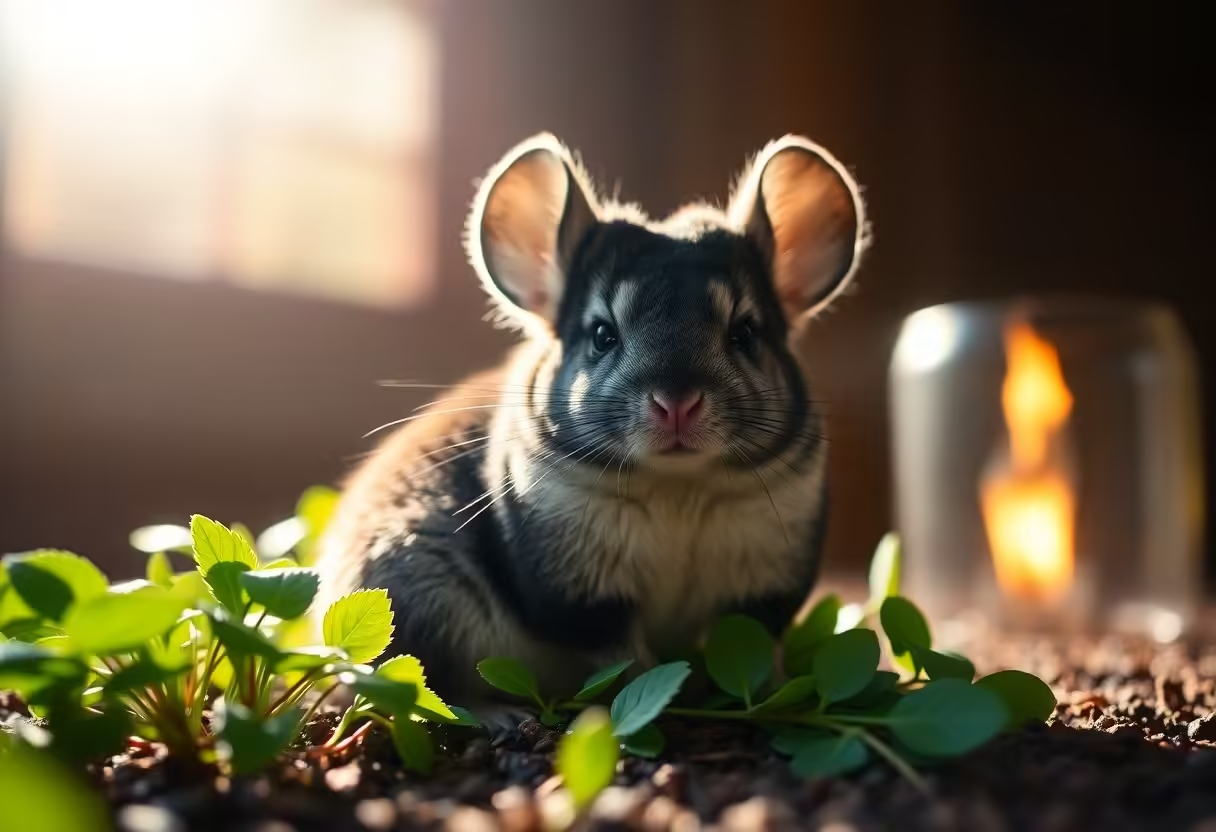Chinchillas thrive in cool environments, with ideal temperatures between 60–70°F. Temperatures above 80°F pose a significant risk of heat stroke, so it’s crucial to monitor their living conditions carefully. Maintaining the correct temperature and humidity ensures your chinchilla stays comfortable, healthy, and happy.
Key Takeaways:
- Chinchillas prefer cool environments, with a temperature range of 60–70°F.
- Temperatures above 80°F can lead to heat stroke, a life-threatening condition.
- Humidity should stay below 60%, as high humidity increases heat stress.
- Signs of overheating include red ears and lethargy.
- Use cooling techniques like frozen water bottles and proper ventilation to keep your chinchilla safe.

Natural Habitat of Chinchillas
Chinchillas are native to the cool, mountainous regions of the Andes in Chile. These areas typically maintain temperatures between 60–70°F with low humidity, which is why chinchillas are adapted to thrive in cool, dry conditions. Their dense fur protects them from the cold, but it also makes them highly sensitive to heat. To mimic their natural environment, it’s essential to maintain a cool and dry living space.
Temperature Preferences
Chinchillas are very sensitive to heat. The optimal temperature range for their comfort is between 60–70°F. Once temperatures exceed 80°F, chinchillas are at risk of heat stroke, which can be fatal if not addressed quickly. Monitoring your chinchilla’s environment is crucial to preventing overheating.
| Factor | Ideal Range | Danger Zone |
|---|---|---|
| Temperature | 60–70°F | Above 80°F (Heat Stroke Risk) |
| Humidity | Below 60% | Above 60% (Increases Heat Risk) |
| Combined Temp + Humidity | Below 150°F | Above 150°F (Overheating Risk) |
Signs of Overheating:
- Red Ears: Chinchilla ears become flushed or red as blood flows to help release excess heat.
- Lethargy: Lack of movement and reduced activity indicate discomfort or heat stress.
- Heavy Panting or Drooling: These are signs of severe overheating, requiring immediate action.
Risks of High Temperatures
What temperature is too hot for chinchillas?
Chinchillas are at risk of heat stroke in temperatures above 80°F. Their dense fur traps heat, making it difficult for them to cool down effectively. If left in high temperatures, chinchillas can suffer from heat stress and eventually heat stroke, which can be fatal.
| Signs of Overheating | Description |
|---|---|
| Red Ears | Indicates heat stress |
| Lethargy | Lack of movement, avoiding activity |
| Panting/Drooling | Difficulty breathing, overheating symptoms |
To prevent these risks:
- Keep their living space between 60–70°F.
- Avoid direct sunlight and poorly ventilated areas.
- Use a reliable thermometer and hygrometer to monitor temperature and humidity.
Humidity Considerations
Chinchillas do best in low-humidity environments, with levels below 60%. High humidity can make it harder for them to regulate their body temperature, especially when combined with warm temperatures. Monitoring both temperature and humidity is essential for their health.
How does humidity affect chinchillas?
High humidity causes discomfort and increases the risk of overheating. Chinchillas struggle to cool themselves effectively, and combined temperature and humidity exceeding 150°F can be dangerous.
Managing Humidity Levels:
- Use a dehumidifier to keep humidity below 60%.
- Ensure proper ventilation in your chinchilla’s habitat.
- Regularly check humidity levels with a hygrometer, such as the ThermoPro TP50.
By controlling humidity and keeping it below 60%, you reduce the likelihood of heat-related health issues.

Cooling Tips for Chinchillas
During hot weather, it’s crucial to take steps to keep your chinchilla cool. Here are a few effective cooling techniques to maintain a safe temperature:
- Frozen Water Bottles: Place frozen water bottles wrapped in fleece inside the cage to provide a cooling surface for your chinchilla. This helps lower their body temperature.
- Fans and Air Conditioning: Use fans or air conditioning to maintain a stable, cool environment. Ensure air flows gently and avoid directing it straight at your chinchilla.
- Cool, Fresh Water: Always provide cool, fresh water to keep your chinchilla hydrated and help regulate body temperature.
- Shaded Location: Keep the cage in a cool, shaded spot away from direct sunlight and heat sources.
Handling and Playtime in Hot Weather
Chinchillas are sensitive to physical activity during hot weather. It’s important to limit handling and playtime when temperatures rise above 80°F to prevent overheating. Physical exertion can raise their body temperature quickly, leading to heat stress.
How can I keep my chinchilla cool during playtime?
- Use a playpen in a temperature-controlled room for short play sessions.
- Provide cool surfaces, like frozen tiles, for your chinchilla to sit on.
- Avoid excessive physical activity when temperatures are high.
Indoor playtime should always take place in a cool, shaded area, with temperatures kept below 80°F.
Final Words
Chinchillas thrive in cool environments with temperatures between 60–70°F and humidity levels below 60%. Temperatures above 80°F can lead to heat stroke, which is life-threatening for chinchillas. To prevent overheating, ensure their environment stays cool, monitor temperature and humidity regularly, and use cooling techniques such as frozen water bottles and proper ventilation. By following these guidelines, you’ll ensure your chinchilla stays healthy and comfortable all year round.
FAQ
Q: Do chinchillas prefer hot or cold weather?
A: Chinchillas prefer cold weather, with ideal temperatures between 60–70°F. High temperatures above 80°F can lead to serious health issues like heat stroke.
Q: What happens to chinchillas in hot weather?
A: Chinchillas can overheat in temperatures above 80°F, leading to heat stroke. Signs of overheating include red ears, lethargy, and panting.
Q: How can I keep my chinchilla cool in warm climates?
A: Provide cool water, use frozen water bottles wrapped in fleece, and maintain temperatures between 60–70°F. Fans and air conditioning can also help regulate the environment.
Q: How does humidity affect chinchillas?
A: High humidity (above 60%) makes it difficult for chinchillas to regulate their body temperature, increasing the risk of overheating.
Q: Is it safe to handle chinchillas in hot weather?
A: No. Avoid handling chinchillas when temperatures exceed 80°F. Excessive handling and activity can cause stress and increase the risk of heat stroke.
